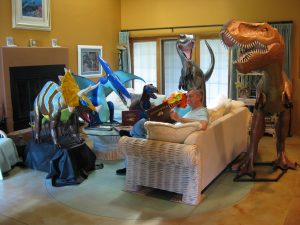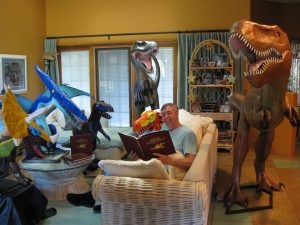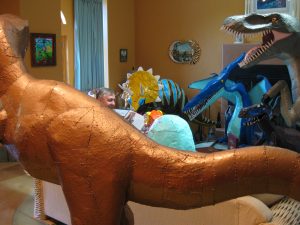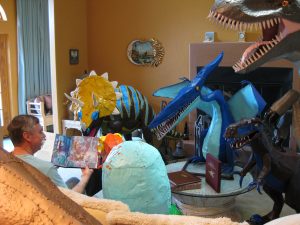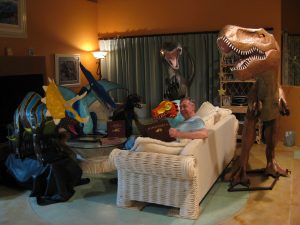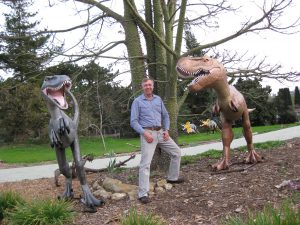We had a “Dinotopia” reading today at the Park. “Dinotopia: A Land apart from Time” and “Dinotopia: The World Beneath” by James Gurney. He created these wonderful stories and published them in 1992 & 1995 respectively. James published two other “Dinotopia” books – “First Flight” 1999 and “Journey to Chandara” 2007. I will have to purchase the last two. His stories are imaginative and his artwork brilliant! The stories are about a continent called Dinotopia, where Dinosaurs live side by side with humans. Dinosaurs speak (English too) and have their own written language. You can see what James is up to on his website jamesgurney.com check it out!
Other Recommended Reading & Reviews:
“Dinosaurs” by Steve Brusatte published 2008 – a Huge Book! (17” X 14”)
- Great illustrations over 170 computer-generated reconstructions based on the most recent information at publication in 2008. Steve Brusatte discusses the origin, evolution and demise of the dinosaurs from the Middle Triassic through the Jurassic to the end of the Cretaceous. The “Bone Wars” – a back and forth struggle between two paleontologists E. D. Cope & O. C. Marsh is discussed. Coverage includes the origin & evolution of Birds, Feathered Dinosaurs in China and new research on T-Rex. Steve’s Cladograms (family trees) are very helpful in understanding the various dinosaur groups and their relation to each other. I found the time periods and their breakdown before each section particularly helpful. Steve’s discussion and the visuals of the earth and land masses at the different time periods ties it all together. The size comparisons to man for each dinosaur are a great visual. The measurements are nice, but the picture gives you the scale you need. A Wonderful Book for every Dinosaur enthusiast’s collection!
Note: A smaller 2010 edition 14” X 12” is available as well in hardcover, which I purchased on Amazon.com
“Dinosaurs The Grand Tour” by Keiron Pim (with field notes by Jack Horner) published 2013
- Truly an “A to Z” listing of Dinosaurs and a few relatives in the family tree. More than 300! Each one is listed with the time period it lived, eating preference, location fossils were discovered, size, what we know or believe based on information at time of printing and many with artist’s drawings. Interesting history about the people making these discoveries and “Field Notes” by Jack Horner, World-Renowned Paleontologists are a bonus! Keiron has quizzes to test your knowledge on the Triassic, Jurassic and Cretaceous periods! A Glossary and Further Reading suggestions are also provided. A Great Book! The further reading will keep me busy for quite a well.
“Pterosaurs” by Mark P. Witton published 2013
- A fantastic book on Pterosaurs 291 pages. When I reached page 100, I ordered one on Amazon.com for myself. The diagrams are great – their bone structure, positions for how they launched into flight, walked and could run on all 4’s! These illustrations will be invaluable for designing Metal Pterosaurs for the Park. Each of chapters 10 – 25 provides detailed information on a particular type of Pterosaur. I never knew there was such a wide diversity. Pterosaurs were more muscular than typically depicted and better flyers than originally thought. Pterosaur eggs were soft and probably buried like reptiles. Fossil eggs studies suggest the babies could most likely fly as soon as they hatched! This book is definitely an incredible resource for me.
“Unearthing the Dragon – The Great Feathered Dinosaur Discovery” by Mark Norell published 2005
- Mark starts with the discovery of Sinosauropteryx – the fuzzy theropod. He provides helpful pronunciation tips for the reader new to Chinese and a history of China’s paleontology activities. Mark offers an interesting view into the different ways east & west view the world. I feel like I have been to China! Mark’s descriptions & Mick’s photos let you experience the sights, sounds, culture and people they met along this journey. I must admit much of the food would have been a challenge for me. Definitely not what you expect or find in the states. I found it interesting that in 1863 Thomas Huxley delivered a paper proposing birds find their origins in dinosaurs. Huxley listed 35 features shared by nonavian dinosaurs and birds. Of these hollow bones and elongated neck bones form the beginnings of the contemporary data set that demonstrates that living birds are descended from dinosaurs. At the time of printing 2005, the author indicated much had changed in the 10 years prior. I’m excited to discover how much more information has become available in the last 11 years. A thoroughly enjoyable read.
“Dinosaurs Without Bones: Dinosaur Lives Revealed By Their Trace Fossils” by Anthony J. Martin published 2014
- A very enjoyable read. Anthony sets up a scene you can visualize and then describes the trace fossils that created the story. He has a great sense of humor with his presentation. You feel as if you are on the trail with him. Anthony provides you formulas to determine height and speed of a dinosaur just from the footprints they left behind! He informs you of the methodology in an entertaining way. I especially enjoyed the discovery of burrowing dinosaurs. It is amazing the insights that can come from non-skeletal fossils.
“Discovering Dinosaurs” by Bob Walters & Tess Kissinger published 2014
- Wonderful book! Nearly 150 dinosaurs are covered, the time periods they lived, what we know about them, colors and patterns. Great information and illustrations! Zuniceratops was discovered by an eight-year old boy in New Mexico. It shows you contributions to the field can be made at any age.
Your Public Library is a great source of information. The Library lets you test drive books for free! You can then decide if you want to purchase them for your permanent collection. The Reference Librarian is definitely your friend in helping you locate the materials you need. Remember to Thank them for their hard work!
Wishing You a Week Full of Discovery!
Paul & Prehistoric Pals
Your feedback is appreciated, Thank you!
